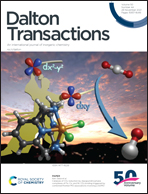Carbazole modification of ruthenium bipyridine–dicarboxylate oxygen evolution molecular catalysts†
Abstract
We synthesized new oxygen-evolving molecular Ru(II) catalysts with one or two carbazole moieties on the axial pyridyl ligands, namely [Ru(bda)(cbz-py)(py)] and [Ru(bda)(cbz-py)2] [C1 and C2; bdaH2 = 2,2′-bipyridyl-6,6′-dicarboxylic acid, py = pyridine, and cbz-py = 9-(pyridin-4-yl)-9H-carbazole] to investigate the effect of cbz modification on the photophysical and catalytic properties of the well-known molecular catalyst [Ru(bda)(py)2] (C0). The initial oxygen-evolving catalytic activities of C1 and C2 were higher than that of C0 in both a chemical reaction driven by the strong oxidant (NH4)2[Ce(NO3)6] (CAN = ceric ammonium nitrate) and photochemical oxidation using a [Ru(bpy)3]2+ (bpy = 2,2′-bipyridine) photosensitizer with Na2S2O8 as the sacrificial oxidant. The higher activities were ascribed to the electron-withdrawing cbz groups, which promoted the radical coupling reaction to form a RuIV–O–O–RuIV species. A unique oxygen-evolution rate change behaviour was observed for both C1 and C2 in the presence of a large excess of CAN, suggesting the competitive oxidation of the cbz moiety during the chemical oxygen evolution reaction. This work suggests that the cbz modification of an oxygen evolution molecular catalyst is a promising approach for integrating the hole accumulator near the oxygen evolution catalytic centre.



 Please wait while we load your content...
Please wait while we load your content...